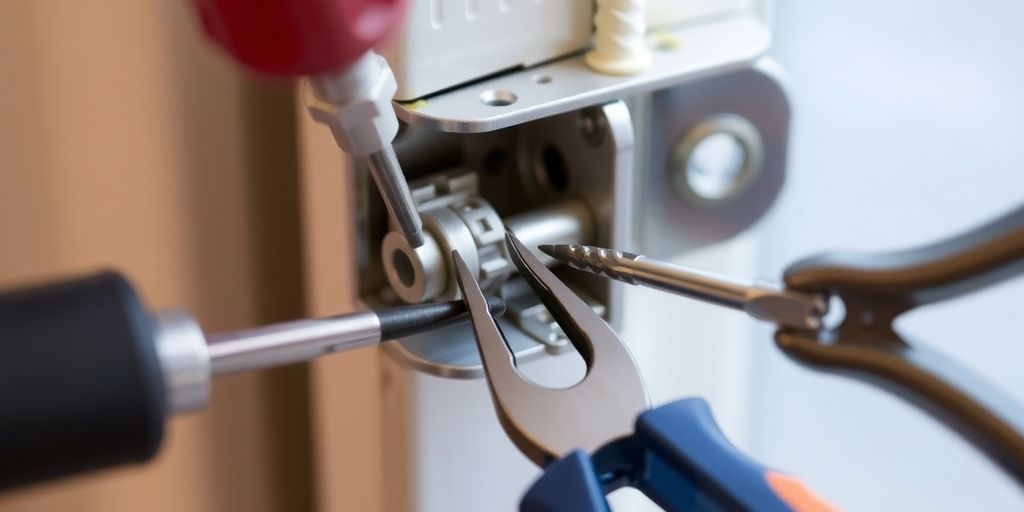
Essential Guide to Screen Door Latch Repair: Tips and Techniques for a Smooth Fix
Repairing a screen door latch can seem daunting, but with the right tools and techniques, you can tackle it yourself. This guide will walk you through the necessary steps to diagnose and fix common latch issues, ensuring your screen door functions smoothly. Whether you're adjusting a strike plate or replacing a latch assembly, you'll find helpful tips to make the process easier and more efficient.
Key Takeaways
- Having the right tools makes repairs easier and faster.
- Identify the issue before starting repairs to save time.
- Regular maintenance can prevent future latch problems.
- Know when to replace parts instead of just repairing them.
- Don't hesitate to call a professional for complex issues.
Tools and Materials Needed for Screen Door Latch Repair
Having the right tools is essential for a successful screen door latch repair. Gathering these items will make your project easier and faster.
Essential Tools for the Job
- Chisel
- Hammer
- Pencil
- Pliers
- Safety goggles
- Screwdriver set (flathead and Phillips)
- Tape measure
- Utility knife
Optional Equipment for Better Results
- File
- Lubricant spray
- Power drill with drill bits
- Replacement latch mechanism
- Sandpaper
- Wood filler
Safety Gear to Consider
- Safety goggles
- Work gloves
- Dust mask
Keeping your tools organized and ready can save you time and effort during repairs.
When you have the right tools, you can tackle any latch issue effectively. For example, using a wrs howard sash cam can enhance the functionality of your screen door, ensuring it operates smoothly. Make sure to check your tools before starting the repair to avoid interruptions.
Diagnosing Common Screen Door Latch Issues
Identifying Alignment Problems
Misalignment is a common issue with screen door latches. If your door won’t latch unless you slam it, the strike plate might be out of alignment. Here’s how to check:
- Close the door slowly and observe where the latch bolt meets the strike plate.
- Look for marks on the door frame indicating where the latch is hitting.
- Check if the strike plate is loose or if screws are missing.
Checking for Wear and Tear
Inspecting for wear and tear is crucial. Look for:
- Rust or damage on the latch components.
- Smoothness and spring action of the latch bolt.
- Any looseness in the door handle.
Regular checks can prevent bigger issues.
Understanding Different Latch Mechanisms
Different types of latches can have unique problems. Familiarize yourself with:
- Spring latches: Common and retract when the handle is turned.
- Deadbolts: Offer better security with a solid bolt.
- Magnetic latches: Use magnets to keep doors closed.
| Latch Type | Description | Common Issues |
|---|---|---|
| Spring Latch | Retracts with handle | Misalignment, sticking |
| Deadbolt | Solid bolt for security | Worn-out mechanism |
| Magnetic Latch | Uses magnets for closure | Weak magnets |
Understanding how your latch works can help you diagnose issues effectively.
By identifying these common problems, you can take the right steps to fix your screen door latch and ensure it operates smoothly. Remember, a well-functioning latch is essential for security and convenience.
Step-by-Step Screen Door Latch Repair Techniques
Once you’ve figured out what’s wrong with your screen door latch, it’s time to get to work. Here are some effective methods to fix common issues:
Adjusting the Strike Plate
If your door doesn’t latch properly, the strike plate might be misaligned. Here’s how to adjust it:
- Remove the strike plate from the door frame.
- Use a file to slightly enlarge the opening of the plate.
- Reattach the strike plate and test the door to see if it latches correctly.
Fixing a Sticky Latch
A latch that sticks can be frustrating. Follow these steps to fix it:
- Take off the latch plate from the door edge.
- Clean the latch mechanism with a degreaser.
- Apply a dry lubricant to the moving parts.
- Reassemble the latch and check if it works smoothly.
- If it’s still sticky, consider replacing the latch mechanism.
Repairing a Loose Door Latch
If your latch feels loose, you can tighten it up:
- Tighten all visible screws on the latch and door handle.
- If screws won’t tighten, fill the holes with toothpicks and wood glue.
- Once dry, reinsert the screws and tighten them.
- For badly stripped holes, use longer screws or a door reinforcement plate.
Regular maintenance can prevent many latch issues. Keeping your latch clean and lubricated will help it function better and last longer.
By following these steps, you can ensure your screen door latch works smoothly and effectively, keeping your home secure and comfortable.
Advanced Screen Door Latch Repair Methods
When it comes to fixing screen door latches, sometimes you need to go beyond simple adjustments. Here are some advanced methods to consider:
Replacing the Entire Latch Assembly
If your latch is damaged or not working well, replacing the entire latch assembly might be necessary. Here’s how to do it:
- Remove the old latch assembly, including the strike plate and door handles.
- Measure the backset (the distance from the edge of the door to the center of the handle) and the door thickness.
- Purchase a new latch assembly that matches these measurements.
- Follow the manufacturer’s instructions to install the new latch.
- Test the new latch to ensure it works properly.
Modifying the Door Frame
In cases where the door frame is misaligned or damaged, you may need to modify it:
- Take off the strike plate and check the door frame’s condition.
- Use a chisel to carefully remove wood from the frame if needed to fit the latch bolt.
- If the damage is severe, consider installing a reinforcement plate or replacing the damaged section of the frame.
- Reattach the strike plate and test the door’s operation.
When to Call a Professional
Sometimes, the issues can be too complex for a DIY fix. If you find yourself in any of these situations, it’s best to call a professional:
- The door frame is severely damaged or rotted.
- You need to modify a fire-rated door.
- You’re unsure about the repair process and want to avoid further damage.
Remember, taking the right steps can save you time and money in the long run. If you’re unsure about any part of the process, don’t hesitate to seek help.
By following these advanced methods, you can ensure your screen door latch functions smoothly and securely. If you need specific parts, consider looking for options like the wrs pivot lock shoe for enhanced durability and performance.
Preventive Maintenance for Screen Door Latches

Regular upkeep can help avoid many issues with door latches and prolong the life of your hardware. Here are some essential tips to keep your screen door latches in great shape:
Regular Cleaning and Lubrication
To ensure your door latches work smoothly, follow these steps:
- Clean latch parts with a mild detergent solution every six months.
- Apply a dry lubricant to moving parts once a year. Avoid oil-based lubricants as they can attract dirt.
- Check for any signs of rust or wear during cleaning.
Periodic Inspection Tips
Make it a habit to inspect your door latches regularly. Look for:
- Loose screws or components.
- Signs of wear or damage.
- Proper alignment with strike plates.
- Smooth operation of handles and latch bolts.
Preventive Replacement of Parts
Some parts wear out over time and should be replaced before they cause problems:
- Replace small components like screws periodically.
- If your latch has a history of issues, consider upgrading to a higher-quality latch.
Regular maintenance can save you time and money on future repairs. Keeping your latches in good condition is easier than fixing them later!
By following these simple steps, you can maintain your screen door latches effectively and avoid unnecessary repairs. Remember, a little effort goes a long way in ensuring your door functions properly!
Troubleshooting and Fixing Related Screen Door Issues

Repairing Torn Screens
Torn screens can be a nuisance, but fixing them is quite simple. Here’s how to do it:
- Remove the screen door from its track.
- Lay it flat on a surface, supporting the ends.
- Take out the old screen material.
- Roll out new screen material, ensuring it’s taut but not overstretched.
- Secure the screen with spline or staples.
Replacing Worn Weatherstripping
Damaged weatherstripping can lead to drafts. To replace it:
- Remove the old weatherstripping with a putty knife.
- Clean the surface where the new one will go.
- Cut the new weatherstripping to size and apply it.
- Check for a tight seal along the door.
Fixing Broken Rollers
If your screen door is hard to slide, the rollers might be the issue. Here’s how to fix them:
- Remove the door from the track.
- Inspect the rollers for damage.
- If they’re dirty, clean them with alcohol; if they’re broken, replace them.
- Reinstall the door and adjust the rollers for smooth operation.
Regular maintenance can prevent many issues. Keeping your screen door in good shape will save you time and effort in the long run.
For a comprehensive fix, consider the wrs push button storm door latch assembly for enhanced security and functionality. This product is part of a larger collection that ensures your home remains safe and efficient.
Final Thoughts on Screen Door Latch Repair
In conclusion, fixing a screen door latch doesn’t have to be a daunting task. With the right tools and a bit of patience, you can tackle common issues like misalignment or sticking latches. Remember to regularly check and maintain your door latches to keep them in good shape. If you ever feel overwhelmed or unsure, don’t hesitate to reach out to a professional for help. A well-functioning screen door not only enhances your home’s security but also makes your daily life easier. Happy repairing!
Frequently Asked Questions
What tools do I need to repair a screen door latch?
You'll need some basic tools like a screwdriver, pliers, and a hammer. A tape measure and safety goggles are also helpful.
How can I tell if my screen door latch is misaligned?
If the door won't latch unless you slam it, or if the latch doesn't line up with the strike plate, it may be misaligned.
What should I do if the latch is sticky?
Try cleaning the latch with a degreaser and applying a dry lubricant. If it still sticks, you might need to replace it.
When should I consider replacing the entire latch assembly?
If the latch is severely damaged or worn out, replacing the whole assembly is usually the best option.
How can I prevent future issues with my screen door latch?
Regularly clean and lubricate the latch, and check for wear and tear to catch problems early.
Is it hard to repair a screen door latch on my own?
Most latch repairs are simple and can be done at home with basic tools. Just follow some easy steps!
